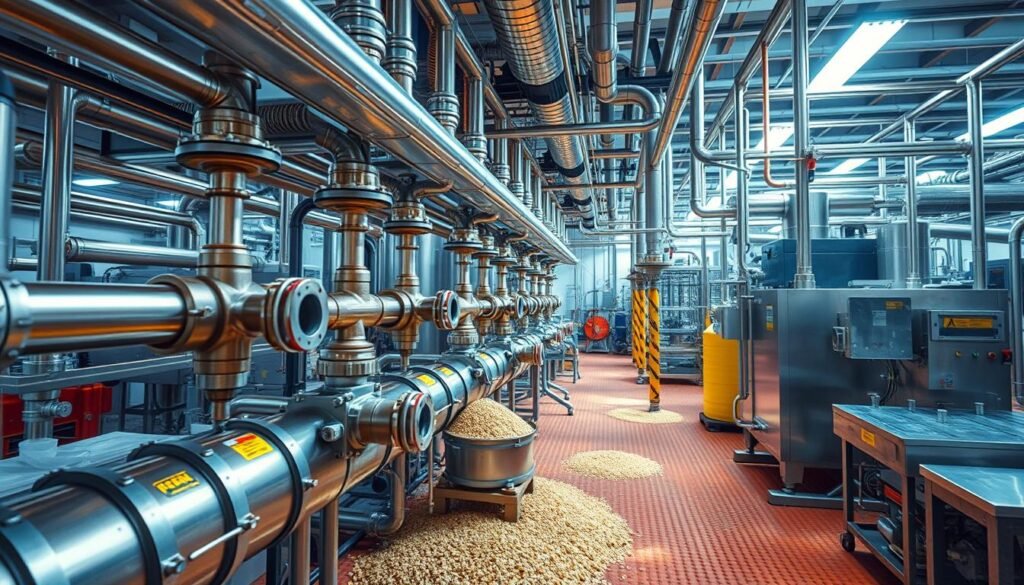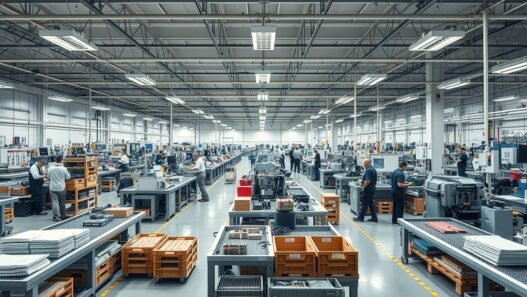Did you know over 70% of industrial automation applications rely on pneumatic systems? These systems use compressed air for various tasks with great efficiency and dependability. They have been improving for more than a century and now lead in several sectors. This includes automotive manufacturing, material handling, and food processing.
Pneumatic systems stand out for their simplicity, robustness, and cost benefits. They can create straight or back-and-forth motions with standard parts, offering crucial support in many fields. Companies like Air Logic have made these systems even better. They provide custom options to meet unique needs, boosting their role in manufacturing today.
Exploring further, we’ll see how pneumatic systems don’t just make operations smoother. They also help keep workplaces safe and efficient in various industrial settings.
Key Takeaways
- Pneumatic systems are crucial for over 70% of industrial automation tasks.
- They operate efficiently using compressed air and are cost-effective.
- Key components include valves, cylinders, and air nozzles.
- Customization in pneumatic systems enhances operational flexibility.
- Proper air preparation is essential for reliable performance.
- Pneumatic technology is prevalent in automotive and food processing industries.
Introduction to Pneumatic Systems
Pneumatic systems use compressed air to create movement. They’re a big step forward in making industries more automated. Thanks to their introduction, tasks get done faster and more efficiently. They work best between 6 to 8 bar pressure, making them both clean and cost-effective for various uses.
At the heart of these systems is compressed air that powers machines. This helps them carry out actions like sorting and lifting. Though only 12% efficient and energy-intensive, their speed and adaptability make them valuable. They’re especially useful where speed trumps exact precision in tasks.
Several industries gain from using pneumatic technology. Whether it’s cement, chemicals, or food production, these systems tailor well to different needs. They send air through pipes easily. The air’s mix—mostly nitrogen and oxygen—affects how well these systems work in practice.
While great for jobs needing medium pressure and quick action, pneumatics aren’t perfect. They can be noisy and must be kept clean to avoid damage. Yet, leaders like Festo are pushing boundaries. They develop products like the BionicSoftArm, a robot that works alongside humans, pointing to exciting future possibilities.
Pneumatic systems are becoming more important every day. Thanks to tech advancements, they’re proving invaluable in various industries. They perfectly blend mechanical movement with automation, making work easier and faster.
What is a Pneumatic System?
A pneumatic system uses compressed air or gas to power things up. It works by transforming the energy in compressed air into force. This force then makes things move, like lifting or holding something.
These systems work with pressures between 6 to 8 kg/sq mm. They are powerful, able to exert forces up to 50 kN. You’ll find them in clean places like integrated circuit lines. Their parts are both affordable and last a long time.
Compressed air flows easily through pipes, so there’s no worry about how far it travels. Pneumatic systems are safer in places with fire risks than those using motors. The basic parts of a pneumatic system include:
- Air compressor
- Pressure switch
- Air receiver
- Air dryer
- Filters
- Lubricators
- Control valves
There are several compressor types essential for these systems. But, these systems aren’t perfect. They can be a bit rough for precise jobs and struggle with heavy loads. They can also be noisy and move in jerky ways. Despite these downsides, pneumatic technology is widely used in things like air brakes and dental drills.
Key Components of Pneumatic Systems
Pneumatic systems use key parts to work well. One main part is the air compressor. It makes compressed air by making its volume smaller, which raises the pressure. There are many air compressors, like piston, rotary, and centrifugal. Each serves different needs.
Another crucial part is the air reservoir. It keeps compressed air ready for when it’s needed. This helps the air compressor last longer because it reduces wear and tear.
Pneumatic valves are important for managing air flow and pressure. They help control the system precisely. Choosing the right valves is key for the system’s efficiency.
Actuators, like cylinders and plunges, turn air power into motion. This is vital for industrial machines to move and work automatically. The right actuators make the system work better and save energy.
Tubing moves compressed air around the system. Using the right tubing and fittings helps avoid leaks. It’s important to check the tubing often to keep the system running well.
High-quality air is vital for these systems. The FRL system ensures the air is clean, well-regulated, and lubricated. This keeps the system working smoothly for a long time.
Good pneumatic circuits make the system safer and more effective. Check valves, for example, stop air from going back into the compressor. Pneumatic systems are flexible and safe, even in dangerous places. They’re also eco-friendly, using clean, compressed air.
Advantages of Using Pneumatic Systems
Pneumatic systems offer big benefits for many businesses. They are notably cost-effective. Their installation and maintenance costs are often much lower than hydraulic systems. This allows businesses to use their resources better.
Another key benefit is their reliability. Pneumatic systems work great in tough conditions. They operate at pressures between 100 and 150 psi. This reduces the risk of leaks and high-pressure fluid dangers found in hydraulic systems.

Safety is very important in industrial places. Pneumatic systems are really good in this department. Using compressed air means no risk of fire or explosion. Also, their self-cleaning feature makes them last longer and reduces contamination risks.
These systems are also easy to keep up. They respond quickly, which is perfect for jobs needing fast movements. Their ability to last under different conditions makes them a good choice for industries using pneumatic technology. This is especially true in automated processes.
In conclusion, pneumatic systems are popular in manufacturing and assembly lines for good reasons. They ensure efficiency, safety, and reliability.
Pneumatic Systems in Industrial Automation
Pneumatic systems are key to improving productivity in many industries. They use compressed air to power tools and machines. This makes them a trusted choice in numerous industrial settings.
These systems are simple to design, durable, and reliable. They are perfect for jobs in manufacturing, packaging, and with air-operated tools. Their small actuators can produce high speeds and forces. This makes pneumatics highly effective in modern manufacturing jobs.
Safety is a huge advantage of using pneumatic systems. In areas where electric power could be dangerous, pneumatics are safer. They don’t need hydraulic fluids, which can leak and need disposal. So, using air is better for the planet.
Pneumatics are chosen by many sectors for their flexibility. They can meet changing needs and support various air requirements. Operating between 80 to 100 psi, they work efficiently and save money.
- Environmentally friendly compared to hydraulic systems
- High-speed operation with excellent response times
- Lower maintenance needs compared to hydraulic options
- Minimal heat and noise generation
Industries like automotive, food and beverage, textile, printing, and agriculture depend on pneumatics. They value the cleanliness, speed, and simplicity these systems offer. Pneumatics ensure efficient operations in many automated setups.
Pneumatic Systems Applications in the Food Industry
Pneumatic systems are vital in the food industry, known for their adaptability and reliability. They achieve great precision in tasks like cutting, mixing, and shaping food. This makes them key in modern manufacturing. The use of clean air makes them especially good for tasks needing high cleanliness.

Pneumatic systems shine in transporting food ingredients through production. They use pneumatic cylinders to move items efficiently. This offers a better power-to-cost ratio than electric drives, boosting productivity in food processing.
In packaging and filling, pneumatic systems play a crucial role. They enable fast and precise control, which is vital for sealing bottles and cans. Clean and dry air is important here to ensure food safety. This underlines the importance of pneumatics in today’s food manufacturing.
The food industry greatly benefits from pneumatic systems. Their simple design, easy installation, and maintenance improve reliability. As the food sector grows, the use of pneumatic systems will likely increase. This will push efficiency and precision in food processing further.
Pneumatic Systems in Material Handling
Pneumatic systems are key in moving different materials. They use compressed air to move bulk goods in pipes. This method is efficient and safe.
They’re great for handling delicate materials without any loss or contamination. Truly, pneumatic systems have changed how we move goods.
Pneumatic systems serve many purposes and offer huge benefits:
- Reduced Material Loss: They lose less material than old-school systems.
- Faster Delivery: They make delivering powders and grains quicker, boosting efficiency.
- Versatile Operation: You can adjust them to work around obstacles easily, helping in warehouses and factories.
- Maintained Material Purity: As closed systems, they keep materials pure and free from outside stuff during the move.
Pneumatic systems are simpler than mechanical ones. This means they need less fixing. Less fixing means less downtime and costs, a plus for any business. Also, they’re safer, especially when moving risky materials.
There are different types of pneumatic conveying like dilute phase, lean phase, medium phase, and dense phase. Each suits different materials, based on air speed and pressure. It’s all about matching the method to the material’s needs for the best results.
| Conveying Type | Gas Velocity (m/s) | Pressure (barg) |
|---|---|---|
| Dilute Phase | 17-18+ | Below 0.1 |
| Lean Phase | Varies | Negative/Positive Pressure |
| Medium Phase | 17-18+ | Up to 0.35 |
| Dense Phase | 6-18 | Above 1 |
Pneumatic systems do best with smaller loads. But, bigger loads can be tricky. You need to think about the size and moisture of particles. Overall, pneumatic systems shine in material handling, ensuring smooth and dependable moves.
Pneumatic Systems in Automotive Manufacturing
Pneumatic systems play a key role in the automotive industry. They boost production efficiency in various manufacturing steps. Uses include filling tires, painting vehicles, and operating robotic tools on assembly lines. These systems are reliable. Their simple parts withstand temperature changes and shocks. This makes them ideal for tough environments.
Pneumatic systems are cost-effective because of their low-cost parts and easy setup. They also need little maintenance. Moreover, they ensure safety in manufacturing plants. Since these systems don’t create sparks, they lower the risk of fires and explosions. This protects workers and equipment in critical areas.
Additionally, pneumatic systems offer the flexibility to control many applications with just one system. They are considered clean power sources, avoiding the issue of leaks that hydraulic systems often face. As technology in the automotive industry advances, pneumatic systems remain essential. They keep processes automated and efficient, cutting down on labor in key jobs like painting and installing parts.















